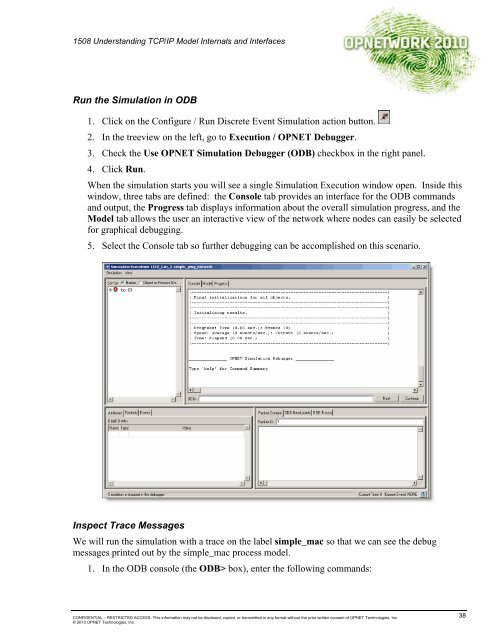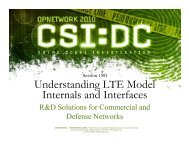Understanding TCP/IP Model Internals and Interfaces
Understanding TCP/IP Model Internals and Interfaces
Understanding TCP/IP Model Internals and Interfaces
You also want an ePaper? Increase the reach of your titles
YUMPU automatically turns print PDFs into web optimized ePapers that Google loves.
1508 <strong>Underst<strong>and</strong>ing</strong> <strong>TCP</strong>/<strong>IP</strong> <strong>Model</strong> <strong>Internals</strong> <strong>and</strong> <strong>Interfaces</strong><br />
Run the Simulation in ODB<br />
1. Click on the Configure / Run Discrete Event Simulation action button.<br />
2. In the treeview on the left, go to Execution / OPNET Debugger.<br />
3. Check the Use OPNET Simulation Debugger (ODB) checkbox in the right panel.<br />
4. Click Run.<br />
When the simulation starts you will see a single Simulation Execution window open. Inside this<br />
window, three tabs are defined: the Console tab provides an interface for the ODB comm<strong>and</strong>s<br />
<strong>and</strong> output, the Progress tab displays information about the overall simulation progress, <strong>and</strong> the<br />
<strong>Model</strong> tab allows the user an interactive view of the network where nodes can easily be selected<br />
for graphical debugging.<br />
5. Select the Console tab so further debugging can be accomplished on this scenario.<br />
Inspect Trace Messages<br />
We will run the simulation with a trace on the label simple_mac so that we can see the debug<br />
messages printed out by the simple_mac process model.<br />
1. In the ODB console (the ODB> box), enter the following comm<strong>and</strong>s:<br />
CONFIDENTIAL – RESTRICTED ACCESS: This information may not be disclosed, copied, or transmitted in any format without the prior written consent of OPNET Technologies, Inc.<br />
© 2010 OPNET Technologies, Inc.<br />
38
















